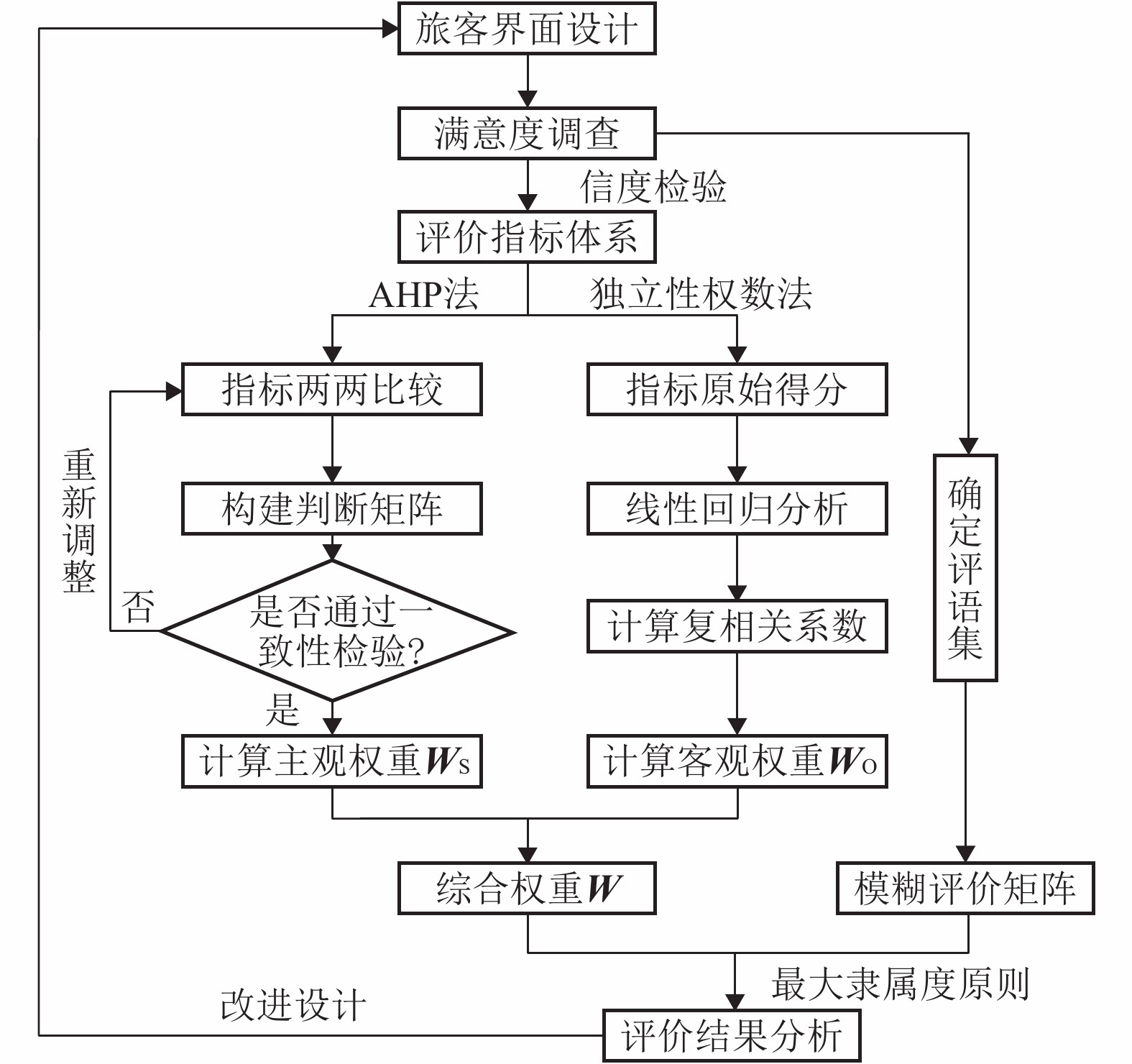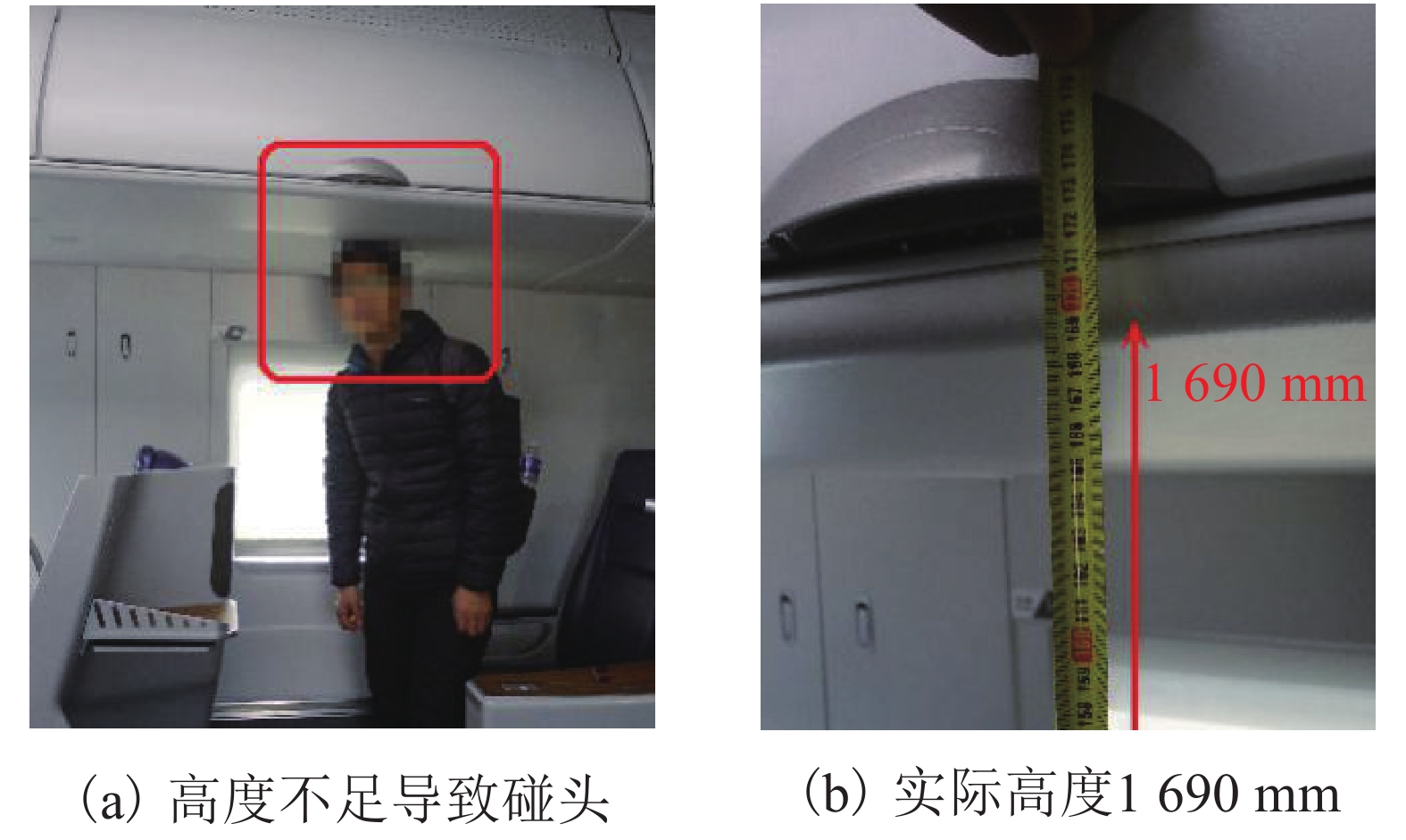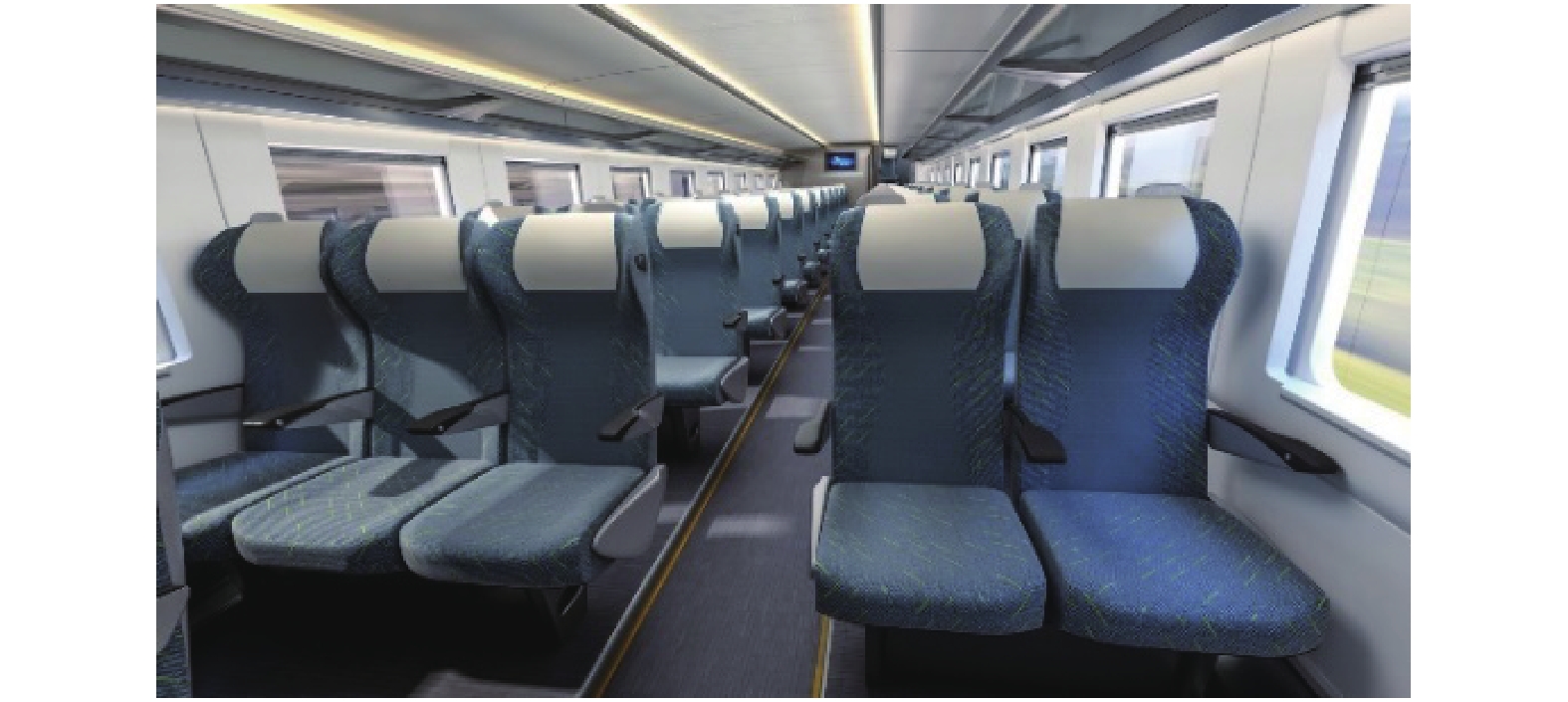Evaluation of Train Passenger Interface Design Based on Analytic Hierarchy Process with Independent Weight Method
-
摘要: 为了克服高速列车旅客界面现有评价模型指标单一、赋权方法主观随意性、缺乏定量分析的局限性,首先,对新型双层高速列车的试验样车展开满意度调查,在此基础上从评价指标的全面性、系统性和层次性出发,构建了由设施尺度、安全设计、功能使用、空间环境和美学设计5类评价准则和36项具体指标组成的层次指标体系;其次,提出一种AHP法(层次分析法)结合独立性权数法赋权值的模糊综合评价模型,保留了专家的主观意见和乘客体验调查数据中的客观信息;最后,基于专家判断数据和调查评分数据求解了旅客界面评价指标体系的各层级权重,解算了新造样车和既有列车的评价等级. 研究结果表明:新造样车的评语等级为满意,隶属度为0.3977,既有列车评语等级为非常满意,隶属度为0.4422;根据权重计算得出旅客界面的设计改进顺序应为设施尺度、功能操作、空间环境、安全设计和美学设计;各评价准则中座椅人机曲面、设施尖角圆润、座椅可调性、空气质量和色彩协调性是对乘客满意度影响最大的因素.Abstract: In order to overcome the limitations of the existing evaluation model of high-speed train passenger interface, such as single index, subjective randomness of weighting method and lack of quantitative analysis. Firstly, a satisfaction survey was conducted on the new type double deck high-speed test sample train. On this basis, starting from the comprehensiveness, systematicness and hierarchy of the evaluation indicators, a hierarchical index system is constructed, which consists of five evaluation criteria and 36 specific indexes, including facility scale, safety design, function use, space environment, and aesthetic design. Secondly, a fuzzy comprehensive evaluation model is proposed, which combines the analytic hierarchy process (AHP) method with independent weight method, it retains the subjective opinions of experts and objective information in the passenger experience survey data. Finally, the weights of each level of the passenger interface evaluation index system are solved based on expert judgment data and survey score data, and the evaluation grades of the new prototype and the existing train are calculated. The results show that the comment grade of the new prototype is satisfactory with the membership degree of 0.3977, and the comment grade of the existing train is very satisfactory with the membership degree of 0.4422. According to the weight calculation, the design improvement sequence of passenger interface should be facility scale, functional operation, space environment, safety design, and aesthetic design. In the evaluation criteria, the man-machine surface of the seat, the rounded corners of the facility, the adjustability of the seat, the air quality and the color coordination are the factors that have the greatest impact on passenger satisfaction.
-
表 1 乘客个体特征描述性统计
Table 1. Descriptive statistics of individual passenger characteristics
项目 性别 年龄/岁 身高/cm 位置 女 男 21~25 26~35 36~45 46~55 154~160 161~170 171~180 181~185 靠窗 不靠窗 样本数/个 40 45 15 36 21 13 9 32 39 5 33 52 占比/% 47.0 53.0 17.6 42.4 24.7 15.3 10.5 37.5 45.5 5.0 38.8 61.2 表 2 高速列车旅客界面设计评价指标体系
Table 2. Passenger interface design evaluation index system for high-speed train
目标层 A 准则层 B 指标层 C 旅客界面设计满意度 设施尺度 B1 座椅布局方式 C1,座椅人机曲面 C2,前后座椅间距 C3,个人隐私空间 C4,厕所空间 C5,收纳空间 C6,过道宽度 C7 安全设计 B2 行李架高度 C8,设施尖角圆润 C9,端门紧急开关 C10,座位进出便捷 C11,开水出水高度 C12,地板防滑 C13 功能使用 B3 垃圾储存方便 C14,行李放置方便 C15,导示信息清晰 C16,厕所使用方便 C17,梳妆镜位置 C18,座椅可调性 C19,功能按键使用 C20,充电方便性 C21,桌板使用方便 C22,阅读方便 C23 空间环境 B4 环境洁净度 C24,空气质量 C25,温度 C26,振动 C27,噪声 C28,照明 C29,压力 C30 美学设计 B5 色彩协调性 C31,造型美观 C32,面料亲和力 C33,设计精致感 C34,设计时代感 C35,设计独创性 C36 表 3 1~9级标度含义
Table 3. Scale meaning of level 1−9
标度 含义 1 i 和 j 指标同等重要 3 i 比 j 稍重要 5 i 比 j 明显重要 7 i 比 j 强烈重要 9 i 比 j 极端重要 2,4,6,8 对应以上相邻判断的中间情况 倒数 若 i 比 j 的判断为 uij,则 j 比 i 的判断 uji = 1/uij 表 4 列车旅客界面评价指标权重
Table 4. Weights of passenger interface evaluation index
评价指标 AHP权重 独立性权数法权重 综合权重 B1 0.4157 0.1988 0.3073 C1 0.1216 0.1366 0.1291 C2 0.3880 0.1816 0.2848 C3 0.2521 0.1491 0.2006 C4 0.1253 0.1468 0.1361 C5 0.0222 0.1317 0.0770 C6 0.0551 0.1305 0.0928 C7 0.0357 0.1237 0.0797 B2 0.1001 0.1976 0.1490 C8 0.2828 0.1907 0.2367 C9 0.4359 0.2044 0.3202 C10 0.0350 0.1469 0.0909 C11 0.1325 0.1602 0.1463 C12 0.0631 0.1555 0.1093 C13 0.0506 0.1424 0.0965 B3 0.2163 0.1936 0.2049 C14 0.0230 0.0872 0.0551 C15 0.0533 0.1063 0.0798 C16 0.0281 0.0996 0.0638 C17 0.0360 0.1000 0.0680 C18 0.0157 0.0934 0.0545 C19 0.3281 0.1135 0.2208 C20 0.1249 0.0875 0.1062 C21 0.1048 0.1044 0.1046 C22 0.2098 0.1083 0.1590 C23 0.0764 0.0999 0.0881 B4 0.2254 0.1914 0.2048 C24 0.0987 0.1465 0.1226 C25 0.4036 0.1577 0.2087 C26 0.0256 0.1350 0.0803 C27 0.0256 0.1360 0.0973 C28 0.1383 0.1495 0.1439 C29 0.2532 0.1366 0.1949 C30 0.0220 0.1387 0.0803 B5 0.0426 0.2184 0.1305 C31 0.4345 0.1682 0.3014 C32 0.2383 0.1771 0.2076 C33 0.1495 0.1633 0.1564 C34 0.0499 0.1636 0.1067 C35 0.0998 0.1664 0.1331 C36 0.0282 0.1614 0.0948 表 5 准则层复相关系数
Table 5. Criterion layer correlation coefficient
准则层指标 复相关系数 决定系数 B1 0.865 0.748 B2 0.869 0.755 B3 0.888 0.789 B4 0.898 0.807 B5 0.787 0.620 -
王智勇,李洋,李娟. 轨道交通车辆内室的人性化设计[J]. 机械设计,2014,31(3): 125-128.WANG Zhiyong, LI Yang, LI Juan. Humanization design on interiors of the railcar[J]. Journal of Machine Design, 2014, 31(3): 125-128. 张卫华. 高速列车顶层设计指标研究[J]. 铁道学报,2012,34(9): 15-19. doi: 10.3969/j.issn.1001-8360.2012.09.003ZHANG Weihua. Study on top-level design specifications of high-speed trains[J]. Journal of the China Railway Society, 2012, 34(9): 15-19. doi: 10.3969/j.issn.1001-8360.2012.09.003 李娟,徐伯初,支锦亦,等. 列车内环境设计对用户满意度及视知觉特性影响分析[J]. 西南交通大学学报,2014,49(1): 179-184. doi: 10.3969/j.issn.0258-2724.2014.01.028LI Juan, XU Bochu, ZHI Jinyi, et al. Analysis on influence of train interior design on user satisfaction and visual perception[J]. Journal of Southwest Jiaotong University, 2014, 49(1): 179-184. doi: 10.3969/j.issn.0258-2724.2014.01.028 李娟,徐伯初,董时羽,等. 基于感性工学的高速列车内环境设计[J]. 机械设计与研究,2013,29(6): 47-49,54. doi: 10.3969/j.issn.1006-2343.2013.06.013LI Juan, XU Bochu, DONG Shiyu, et al. Research on high-speed train interior aesthetic design based on kansei engineering[J]. Machine Design & Research, 2013, 29(6): 47-49,54. doi: 10.3969/j.issn.1006-2343.2013.06.013 姜良奎,向泽锐,刘峰. 无辅助抓握件地铁车内扶手布置设计研究[J]. 包装工程,2017,38(2): 15-20.JIANG Liangkui, XIANG Zerui, LIU Feng. Layout design of handrails without assistive handles for metro vehicles[J]. Packaging Engineering, 2017, 38(2): 15-20. 章勇,徐伯初,支锦亦,等. 高速列车旋转座椅的人机工程改进设计[J]. 机械设计,2016,33(8): 109-112.ZHANG Yong, XU Bochu, ZHI Jinyi, et al. Improved design on human-machine engineering for the rotary seat of high speed train[J]. Journal of Machine Design, 2016, 33(8): 109-112. 支锦亦,向泽锐,梁刚毅. 面向轨道装备的可视化人因综合仿真分析平台研究[J]. 包装工程,2017,38(2): 1-7.ZHI Jinyi, XIANG Zerui, LIANG Gangyi. Visual comprehensive human factors simulation analysis platform for rail equipment[J]. Packaging Engineering, 2017, 38(2): 1-7. 魏峰,董石羽,徐伯初,等. 基于模糊层次分析的高速列车座椅舒适度评估与应用[J]. 机械设计,2017,34(4): 119-123.WEI Feng, DONG Shiyu, XU Bochu, et al. Comfort evaluation and application of high-speed train passenger seat based on FAHP[J]. Journal of Machine Design, 2017, 34(4): 119-123. THOREAU R, HOLLOWAY C, BANSAL G, et al. Train design features affecting boarding and alighting of passengers:train design affecting boarding and alighting[J]. Journal of Advanced Transportation, 2016, 50(8): 2077-2088. doi: 10.1002/atr.1446 LEE J H, JIN B S, JI Y. Development of a structural equation model for ride comfort of the korean high-speed railway[J]. International Journal of Industrial Ergonomics, 2009, 39(1): 7-14. doi: 10.1016/j.ergon.2008.09.003 ALPU O. A methodology for evaluating satisfaction with high-speed trainn,services:a case study in Turkey[J]. Transport Policy, 2015, 44(11): 151-157. 周韶泽,杨文庆,聂春戈,等. 基于虚拟现实的动车组虚拟检修仿真研究[J]. 机械设计与制造,2020(3): 190-193. doi: 10.3969/j.issn.1001-3997.2020.03.046ZHOU Shaoze, YANF Wenqing, NIE Chunge et al. Simulation research of EMU virtual maintenance based on virtual reality[J]. Machinery Design & Manufacture, 2020(3): 190-193. doi: 10.3969/j.issn.1001-3997.2020.03.046 魏峰,徐伯初,支锦亦,等. 地铁客室乘坐设备人机功能尺寸设计[J]. 西南交通大学学报,2018,53(4): 865-872. doi: 10.3969/j.issn.0258-2724.2018.04.027WEI Feng, XU Bochu, ZHI Jinyi, et al. Man-machine functional dimension design of riding equipment in subway passenger compartments[J]. Journal of Southwest Jiaotong University, 2018, 53(4): 865-872. doi: 10.3969/j.issn.0258-2724.2018.04.027 裴卉宁. 基于工效学负荷理论的民机客舱乘坐舒适度评价方法[D]. 西安: 西北工业大学, 2018. 黄风立,赵燕伟,华尔天. 基于满意度的模糊机会约束模型在产品设计中的应用[J]. 中国机械工程,2004,15(24): 2222-2225. doi: 10.3321/j.issn:1004-132X.2004.24.016HUANG Fengli, ZHAO Yanwei, HUA Ertian. Applications of fuzzy chance constrained model in product design based on satisfaction[J]. China Mechanical Engineering, 2004, 15(24): 2222-2225. doi: 10.3321/j.issn:1004-132X.2004.24.016 SAATY T L. How to make a decision:the analytic hierarchy process[J]. European Journal of Operational Research, 1994, 24(6): 19-43. -





 下载:
下载:



